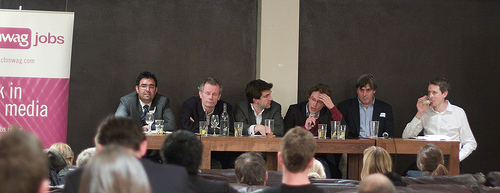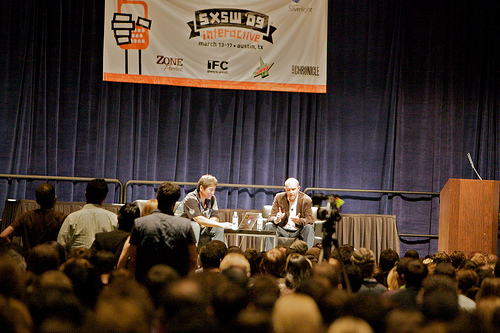Three Reasons Free Will Eat Itself
 It’s the meme that wouldn’t die, but die it should… Last week I attended the Chinwag Live ‘Freeconomics’ session in London, and not long before that I listened to Guy Kawasaki interviewing Chris Anderson at South by South West. While Chris dodged Guy’s low-ball questions out at SXSWi, and focussed on promoting his new book (which may or may not be free), the Chinwag Live panel got a bit more stuck in.
It’s the meme that wouldn’t die, but die it should… Last week I attended the Chinwag Live ‘Freeconomics’ session in London, and not long before that I listened to Guy Kawasaki interviewing Chris Anderson at South by South West. While Chris dodged Guy’s low-ball questions out at SXSWi, and focussed on promoting his new book (which may or may not be free), the Chinwag Live panel got a bit more stuck in.
The whole ‘free’ thing is worth wrapping your head around. It is probably worth starting with Chris Anderson’s article from last year, but then reversing out a bit with Alan Patricks two great posts on Freeconomics: PART I and PART II and his notes from the panel: CHINWAGGING or the podcast). You can read a journal of the panel session on the Bluedoor blog, where Abigail has blogged her tweetage, as it were, and there is a full write up at Brandrepublic.
 You see, ‘free’ isn’t really free at all. It’s been funded by the VCs and selling data, and the VCs aren’t playing anymore. The concept of Anderson’s free is that transactional costs (the price of ‘doing things’) tends to zero on-line and at scale. However, transactional costs tending to zero is very different then them being zero see… Someone’s got to pick up the tab, see Nic Brisbourne’s post, and I quote:
You see, ‘free’ isn’t really free at all. It’s been funded by the VCs and selling data, and the VCs aren’t playing anymore. The concept of Anderson’s free is that transactional costs (the price of ‘doing things’) tends to zero on-line and at scale. However, transactional costs tending to zero is very different then them being zero see… Someone’s got to pick up the tab, see Nic Brisbourne’s post, and I quote:
The other takeaway that I hadn’t considered fully is that for many services in reality the marginal cost of delivery is not zero. This was made most forcefully by panelist Alan Patrick, but also by panelist Bruce Daisely of YouTube who made the point that the worlds favourite video service now accounts for 10% of total bandwidth consumption – which I’m sure costs Google a lot of money. This point knocks a sizeable whole in the ‘free’ argument, although ‘free’ fans would argue that these costs are going down all the time.
So, I threw in a question at the end, on the basis of these three forces “Won’t free end up eating itself?”
1. Free Attracts The Freeloaders.
If you advertise your service as free, hoping to up sell people to a paying service later (the freemium model), you may well be attracting the wrong crowd. I don’t mean in the sense of bad people, but rather the people that want something for free. That leaves those who want to pay as potential customers for a competitor. More importantly, you have probably attracted ‘customers’ that choose on price (free), rather than features. I put the word customers in quotes there very deliberately. Since they aren’t paying you anything, they aren’t really customers. They are prospects. And that is where ‘free’ is interesting: As a marketing ploy. It is a good one. But wait up…
2. Free Drives Value Out of the Market.
Imagine there’s a nice bar. A really nice bar. They charge £10 per drink, but it’s nice and you like it there, so you pay your £10. Now, someone opens up a bar next door. The drinks are free. I mean £0 free. You’re going to check it out aren’t you? Seriously. At least once? The £10 bar is going to loose at least some revenue, if not customers. You’re running the £10 bar. What will you do? Drop prices? A buy-one-get-one-free offer?
Markets are elastic. If someone enters the market with a lower priced offer, it drags prices down. It’s called competition, and it’s generally a good thing. As customers, we like it. However, when someone enters the market at ‘free’ it isn’t the usual ‘more efficient competitor’ entering. No, it’s a value destroying monster. Value will disappear from the market. That inevitably means that companies will too, which will reduce competition in the long run – and that isn’t good. And the competition that’s left? Oh, it’s bad…
3. Free Spreads Across Markets.
Traditional competition focusses on price. As marketers, we try and combat price competition by introducing features that (in our minds at least) create value and preserve the price. Some choose to build more efficient businesses, so that they can compete on price, but maintain margins. In the world of ‘free’ you can’t compete on price. You have to compete on features (or quality, which I’d argue is a feature anyway). That means wherever two players are in the same market with a ‘free’ offer, the temptation, if not the action, will be to gradually add more and more features. Think about the value for the market. More and more of what was revenue, ends up as ‘free’. Remember those ‘freemium’ businesses, giving you free stuff, hoping to upgrade you? There is less and less to upgrade you to that isn’t free.
Free is a Short-Term Win and a Long-Term Lose
‘Free’ feels good, but it is really an inevitable race to the bottom, ensuring that markets are destroyed by low price expectations and poor (service) quality. Watch the providers of ‘free’ – as advertising revenues (and tolerance for advertising) falls, and VC money dries up, expect them to come asking for money or to start selling your data to the highest bidder. The end of ‘free’ might well come from the strangest of places: mobile e-commerce. The latest iPhone software let’s you make payments within iPhone apps themselves. That’s iPhone apps that you probably paid for in the first place too! Nokia, Microsoft and a host of others are planning similar offers.
The Way out of Free is Utility
As much as product marketers bang on about the latest much have feature, one thing that we do pay for is utility. I can make a local phone call very cheaply, if not for free – depending on where I am. That same phone call costs significantly more on a mobile/cell phone, and yet the technology took off. People were paying for utility: being able to make calls from anywhere, not just when they were stuck in the house or the office. It made great sense as people became more and more mobile. And, as the technology took off, people got more and more mobile in their work and social lives, driving the technology even faster.
So far, the Internet is just catching up with the whole mobility thing. Web browsers are improving in leaps and bounds, as is the provision of mobile-friendly websites and improved screens on phones. Mobile Internet is taking off. And do you know what? It probably isn’t going to be ‘free’.


[…] http://redcatco.com/blog/marketing/three-reasons-free-will-eat-itself/ […]
Benjamin
Great post and sharp analysis.
At proofHQ (http://www.proofhq.com) we have been thinking long and hard about this issue.
We have a web app aimed at designers, creatives and marketing teams. It simplifies and takes cost out of the design review and approval process.
We tested various price points and trial periods and saw first hand what you hypothsise.
First, we had much stronger conversions when we reduced our trial from 30 days to 14. We think that is because of the urgency and seriousness that a shorter trial conveys.
Second, we offer a Personal plan which is free ongoing and a range of increasingly bigger paid plans. People can take a free trial of any plan, but the vast majority choose the Personal plan even for the trial. The conversion rate of people who trial a paid plan is much higher than ones who start with the Personal plan. We are not sure what to conclude from this. Perhaps people looking seriously at tools like ours want a serious trial.
Third, we have thought about offering more under the free Personal plan, but we are hesitating. Our lowest priced plan used to be $29 per month. We started offering a plan at $17 a month. We did not see a huge increase in paying customers, and only saw some small cannibalisation of the $29 signups. Our conclusion is that the price elasticity between any paid plan is on a normal curve, but the big inflection point is from free to $1. I know that this has been discussed before, but it was certainly validated.
Thanks again for raising the subject.
Hello Mat,
You might want to flip back to the on-line trust for answers to some of the behaviours you’ve seem.
Reciprocity (I feel I owe you because you’ve given me something) can work in your favour – if the service is positioned as $x per month, but I’m giving you a special 100% discount that can buy some good will. Likewise, urgency has always been an effective marketing tool – even in the land of free.
Price elasticity is a curious thing – it has floor and ceiling effects. Reduce prices below a certain level, or push them above a certain level and the elasticity breaks. Understanding the effective range is a challenge, even for a very good product manager.
Another technique I’ve seen used in free services is the “step on-push off” idea. The service is free, but an ‘advanced’ pay-for feature is included ‘free’ for a. After that it is removed or you can switch to paying for it.
A has to be long enough for the ‘advanced’ feature to become something that is used by the customer everyday, and the feature has to be quite compelling. It’s a dangerous game, since it can irk customers, but I am seeing it used more and more as a tactic to get people to upgrade. Likewise, randomly giving free users trials of the advanced service can also increase the upgrade yields.
That said, the key for the freemium model is to get users to be passionate enough about the service to want to pay – regardless of what features they use. Flickr has done this well. Making the paid for service a badge of honour.
There a behavioural differences between consumer and business services, and most of the people I’ve talked to simply don’t get that – which I’d be very worried about if I was one of their investors.
With the plans and paid plans and the trial conversions you mention, I’d say you are probably tapping into deferent market psychographics, hence the different behaviours.
Some great validation in there – thank you again for sharing!
[…] post on Three Reasons Free Will Eat Itself drew a fair bit of attention. To be clear, I’m not anti-free by any means – I think it can […]